Physical Address
304 North Cardinal St.
Dorchester Center, MA 02124
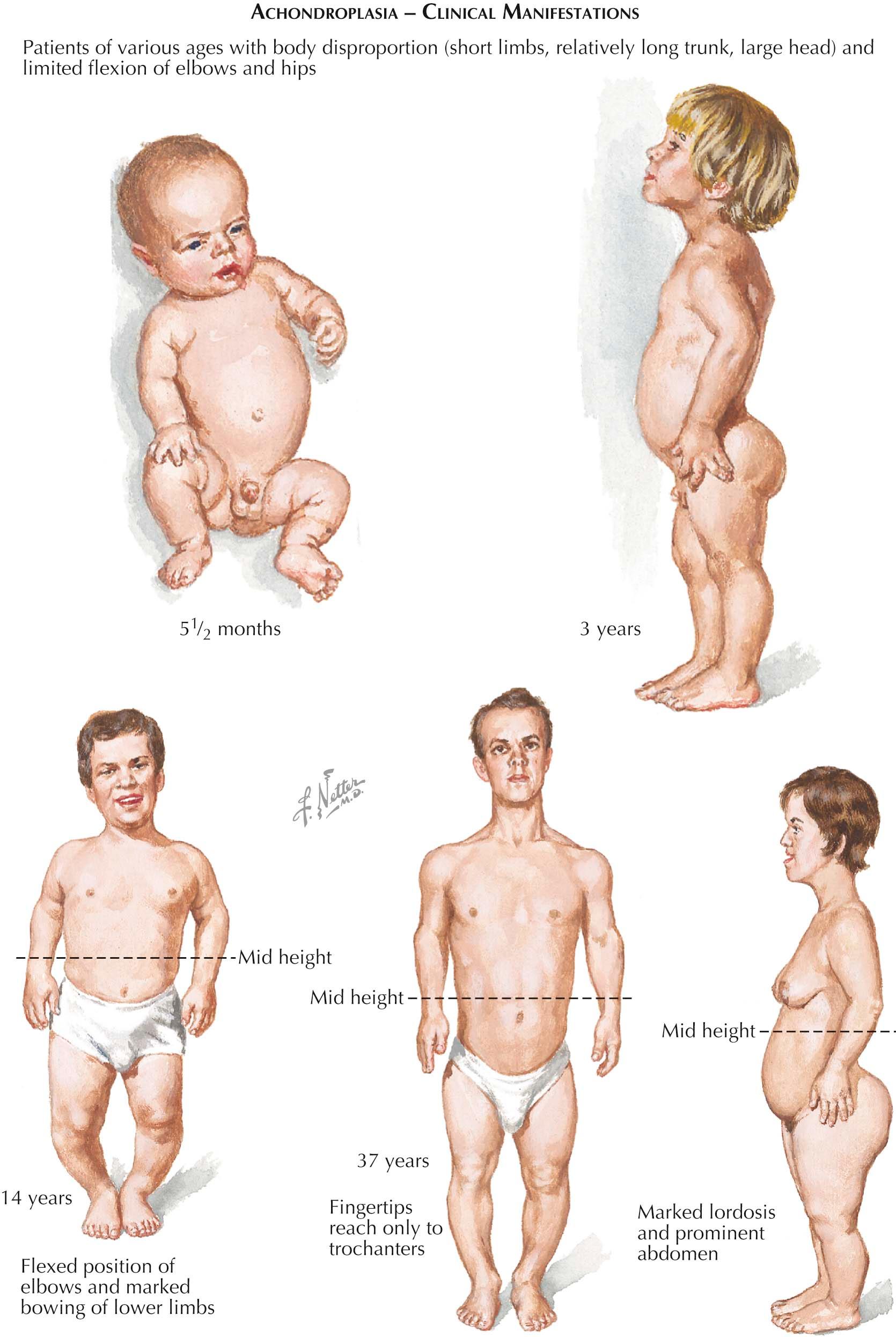
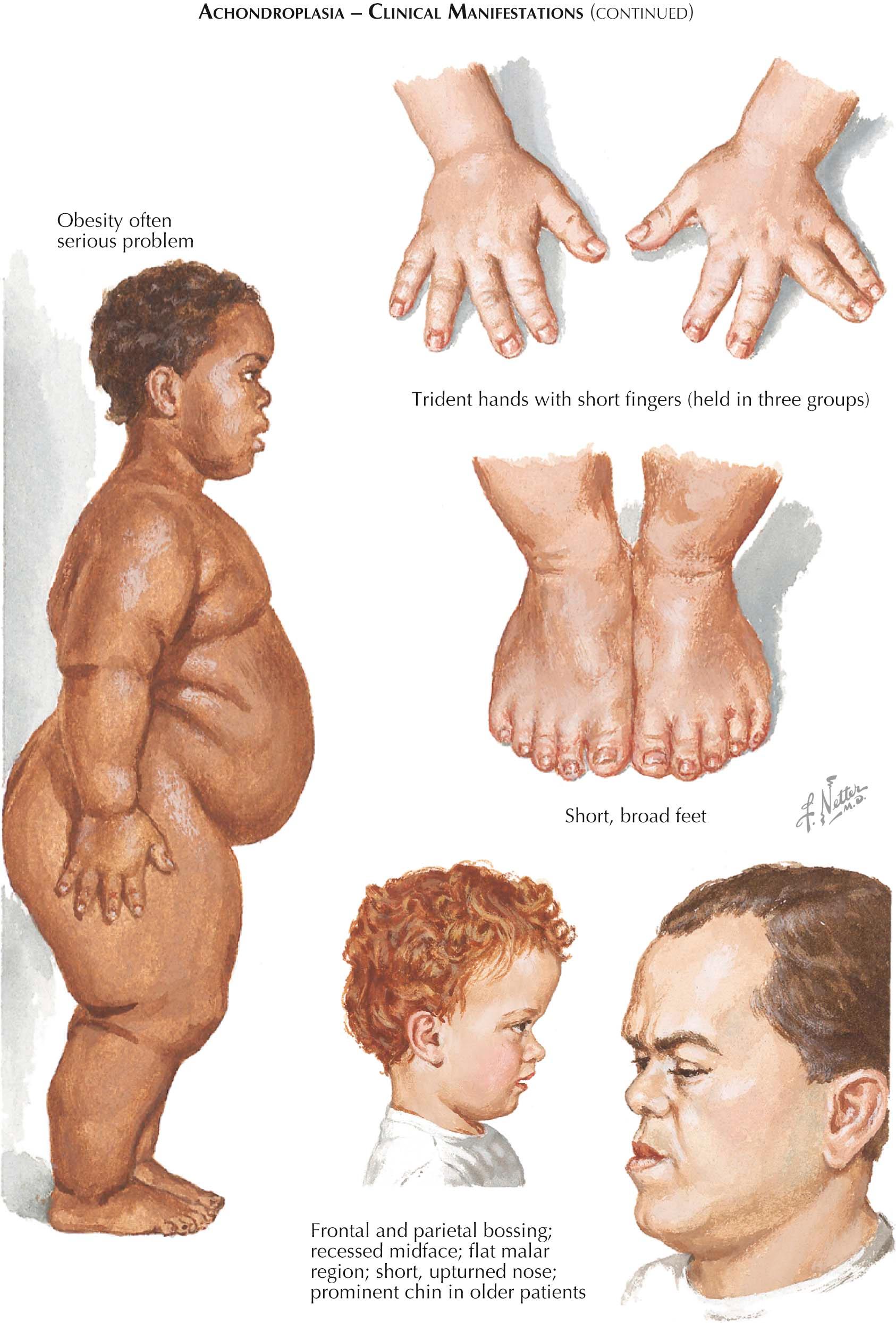
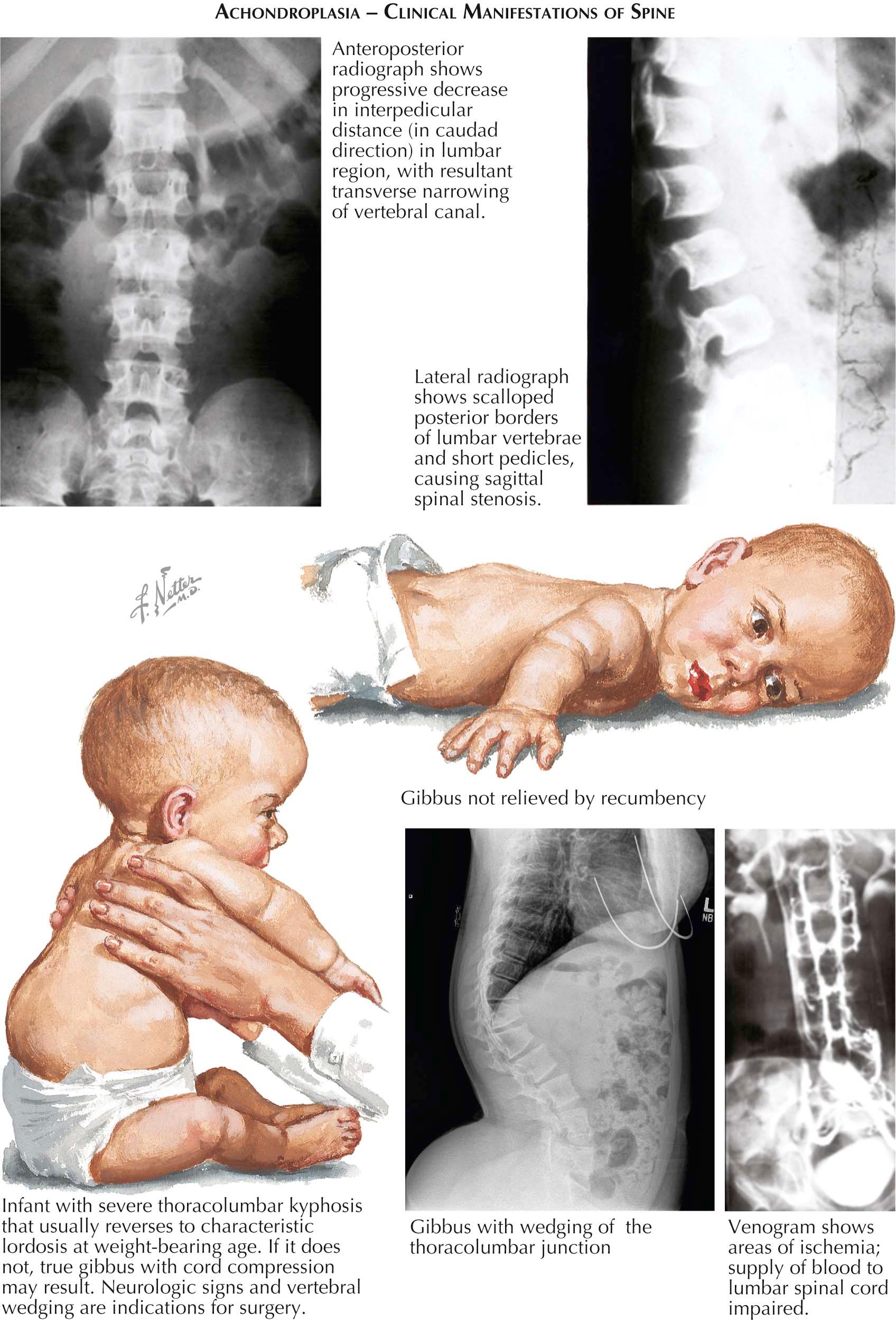
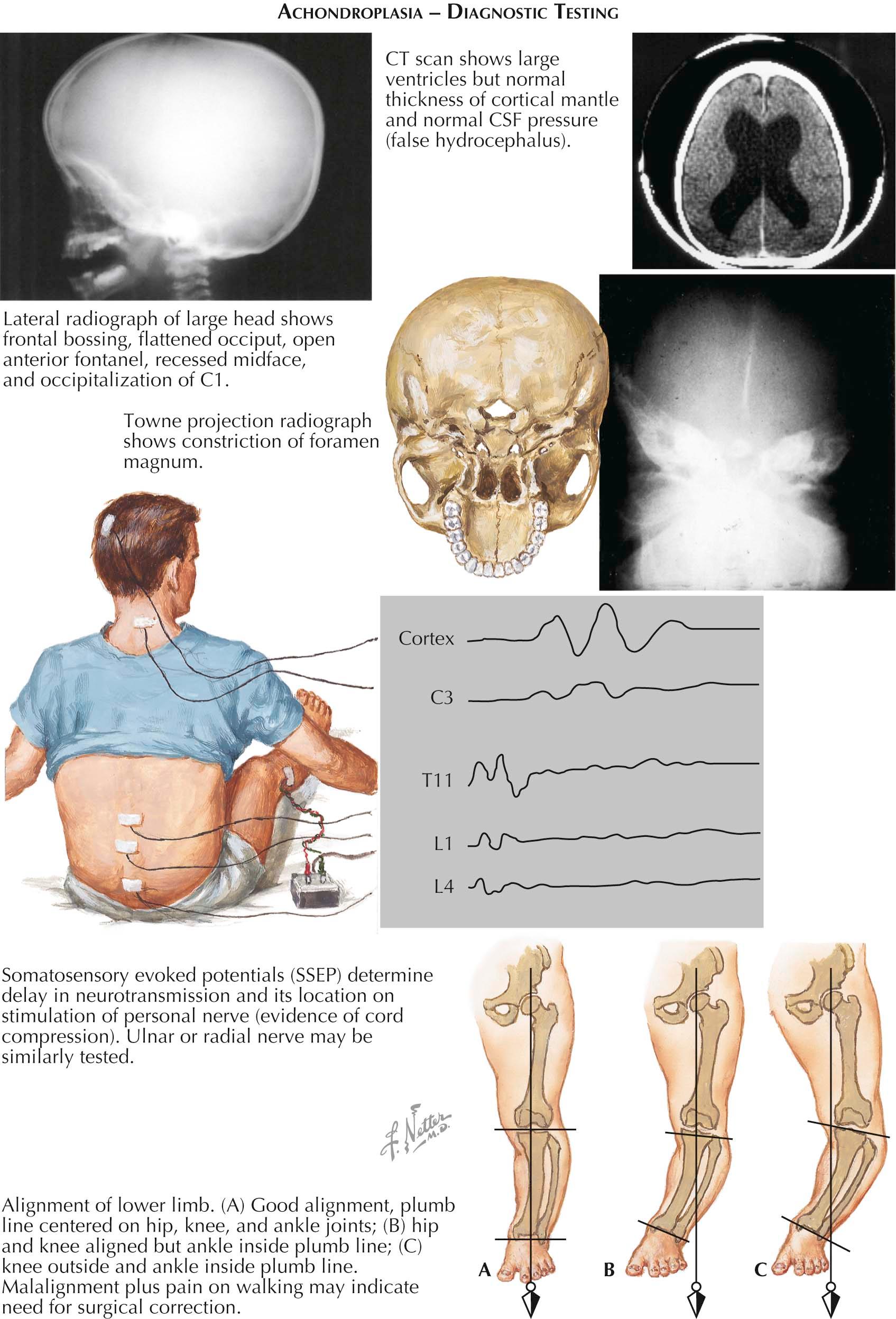
Although hereditary disorders of the skeleton are relatively rare, they attract a great deal of interest. Many of these disorders are associated with short stature, or dwarfism. Dwarfism can be either proportionate or disproportionate. Symmetric shortness of the trunk and limbs is common with proportionate dwarfism. Disproportionate dwarfism, in which either the trunk or limbs are more affected than the other, is common with skeletal dysplasias such as Kniest syndrome, spondyloepiphyseal dysplasia, achondroplasia, and so on.
Skeletal dysplasias, or chondrodystrophies, are a heterogeneous group of disorders resulting in short-limb or short-trunk types of disproportionate short stature. In the types of dwarfism that primarily affect the limbs, the shortening may predominate in the proximal segments (rhizomelia), the middle segments (mesomelia), or the distal segments (acromelia). The term dwarf has traditionally been applied to persons of disproportionate short stature, whereas the term midget referred to those of proportionate short stature.
Disproportionate dwarfism is caused by a hereditary intrinsic skeletal dysplasia, whereas proportionate dwarfism results from chromosomal, endocrine, nutritional, or nonosseous abnormalities. Over the past several years, we have gained further understanding regarding the mode of inheritance, the genetic defect, and the fundamental biochemical and/or molecular fault that causes the dysplasia. Many cases of dwarfism are the result of a rare genetic event, the spontaneous mutation. Unaffected parents of a child with a mutation are essentially at no risk of having another affected child, and unaffected siblings are not at risk of having children with the disorder. Affected parents may pass the trait on to their children, depending on the mode of inheritance—autosomal dominant, autosomal recessive, or X-linked.
Genetic counseling must be based on an accurate diagnosis and on familiarity with the natural history, range of manifestations, severity, and associated findings of the specific disorder.
Prenatal Testing. Prenatal diagnosis of certain skeletal dysplasias without biochemical markers can be established by radiography (less commonly used), ultrasonography (most widely used), fetoscopy, amniography, three-dimensional ultrasonography, fetal magnetic resonance imaging (MRI), and intrauterine computed tomography (CT). Knowledge of the natural history of intrauterine growth in dwarfing conditions is incomplete. Ossification of the fetal skeleton is not well established until 16 weeks, and it is not known when limb-length discrepancy becomes apparent in the fetus. Serial sonograms are necessary to recognize the decreased growth rate of the femur or to monitor the fetal biparietal diameter, polydactyly, clubfoot, and other skeletal abnormalities.
History. A thorough family history is a particularly important factor in reaching the correct diagnosis. Because disorders with clinically indistinguishable features may have different patterns of inheritance, evaluation of other family members can be very helpful. Genetic testing can also be helpful because clinically some disorders can appear similar to one another. Genetic testing can help to define the disorder and also help with expectations for future generations.
Physical Examination. Measurements of head circumference, height, weight, and arm span are taken, and body proportions are evaluated. A careful examination should be done for nonosseous signs such as cleft palate, cataracts, or congenital heart disease that may contribute to the diagnosis. Ophthalmologic examination and evaluation of speech and hearing may also be needed.
Intelligence is normal in nearly all types of dwarfism. Exceptions include, but are not limited to, hypochondroplasia (see Plate 4-5 ), the rare Dyggve-Melchior-Clausen dysplasia (see Plate 4-16 ), pycnodysostosis (see Plate 4-13 ), and Hurler and Hunter syndromes (see Plate 4-18 ). The need for specific intellectual evaluation or treatment is dictated by the diagnosis and the patient's past performance.
Radiographic Findings. Radiographs must be taken of the entire skeleton (skeletal survey) because diagnosis of most bone dysplasias cannot be made on the basis of one or two radiographs of selected body parts. It is particularly important to look for atlantoaxial instability of the cervical spine. Abnormal vertebral movements occur in many bone dysplasias and, unless detected, may lead to acute compressive myelopathy. Because the radiographic characteristics of many dysplasias change with time, review of earlier radiographs is often necessary (e.g., in the epiphyseal dysplasias, the growth plates fuse with age and all evidence of disturbed epiphyseal development is obliterated).
Laboratory Tests. Initial symptoms or the preliminary diagnosis may suggest the need for specific laboratory tests. For example, if Schmid-type metaphyseal chondrodysplasia (see Plate 4-3 ) is suggested, a complete blood analysis is needed to differentiate this disorder from vitamin D–resistant rickets; and if the mucopolysaccharidoses, a group of biomechanical storage disorders, are suggested, testing for specific enzymes is required.
Achondroplasia, which occurs in about 1 in 40,000 persons, is the most common and best-known type of disproportionate short-limb dwarfism (see Plates 4-1 to 4-3 ). It is transmitted by a single autosomal dominant gene. Infants with homozygous achondroplasia generally do not survive for more than a few weeks or months. About 80% of cases result from a spontaneous mutation. The mutation occurs in the fibroblast growth factor receptor 3 (FGFR-3), which affects endochondral bone formation specifically in the proliferative zone of the physis. Achondroplasia is a quantitative, not qualitative, cartilage defect. The parents are usually average size, and no other family member is affected. Statistical evidence suggests that elevated paternal age (>37 years) may be linked to this type of mutation.
Clinical Manifestations. The characteristic signs of achondroplasia—disproportionate short stature, a comparatively long trunk, and rhizomelic shortening of the limbs—are evident at birth (see Plates 4-1 and 4-2 ). The head is both relatively and absolutely large with a prominent, or bulging, forehead (frontal bossing); parietal bossing and flattening of the occiput may also be evident. In infancy, the head increases rapidly in size and hydrocephalus can occur. It can be recognized early by using established norms for head size in patients with achondroplasia, and appropriate treatment can be instituted.
Midfacial hypoplasia of variable degree is manifested by a flat or depressed nasal bridge, narrow nasal passages, and malar hypoplasia (see Plate 4-2 ). The nose has a fleshy tip and upturned nostrils. These features result from restricted development of the chondrocranium and the middle third of the face.
Recurrent and chronic middle ear infections (otitis media) are common in infancy and early childhood and, if untreated, may lead to significant hearing loss. Generally, these infections become less frequent by the time the patient is 8 to 10 years of age.
A relative protrusion of the jaw is often mislabeled as prognathism. Dental development is normal, but underdevelopment of the maxilla may cause dental crowding and malocclusion. About 70% of patients have tongue thrust or other speech defects that seem to be related to the dysplastic bone structure. These problems usually subside spontaneously by school age.
The root portions of the limbs are shorter than the middle or distal segments. Soft tissues may appear excessive with redundant, partially encircling folds and grooves on the limbs. Because the long bones are shortened, the muscle mass looks bunched up, creating the appearance of great strength.
Initially, the legs appear straight but with ambulation may develop a varus position, resulting in bowleg (genu varum) with or without back knee (genu recurvatum).
The hands and feet may appear large in relation to the limbs, but the digits are short, broad, and stubby (brachydactyly). The so-called trident hand (see Plate 4-2 ) is common but becomes less apparent in late childhood and adulthood. The fingertips may reach only to the level of the trochanters or even the iliac crests. Elbow extension is restricted (30 to 45 degrees), but this has little functional significance. In some instances, this may be due to radial head subluxation.
Although the trunk is relatively long, deformities contribute to the overall height reduction. The chest tends to be flat and broad and the abdomen and buttocks protuberant. Excessive lumbar lordosis and a tilted pelvis cause a waddling gait, and fixed flexion contractures of the hip appear early.
In a sitting position, infants commonly exhibit thoracolumbar kyphosis (see Plate 4-1 ). A hump, or gibbus, seen in some infants, may be associated with anterior wedging of the first or second lumbar vertebra. The kyphosis is related to a variety of factors, including ligamentous laxity, hypotonia, and immature strength and motor skills. Although it requires monitoring, the kyphosis usually disappears when the child begins to walk.
Neurologic complications are common. Respiratory abnormalities suggest stenosis of the foramen magnum and compression of the normal-sized medulla oblongata and/or cervical spinal cord. This quite frequent complication results in hypoventilation or apnea, paralysis of voluntary respiration, and compressive myelopathy at the level of the foramen magnum (see Plate 4-4 ). (Therefore, hyperextension of the neck and sudden, whiplash-like movement should be avoided.) Sudden infant death syndrome has also been reported. Somatosensory evoked potential (SSEP) and polysomnography coupled with CT and MRI can provide valuable information to help avert both short-term and long-term complications.
Stenosis of the lumbar spine, prolapse of intervertebral discs, osteophytes, and deformed vertebral bodies may compress the spinal cord and/or nerve roots, frequently causing neurologic manifestations. Pressure on blood vessels impairs the regional blood supply, producing focal areas of ischemia. The pedicles tend to be short and the interpedicular distance tends to decrease (instead of the normal increase) caudally in the spine.
In the teenage period, slowly progressive symptoms such as paresthesias, weakness, pain, and paraplegia develop and may be aggravated by obesity and prolonged standing or walking. Initially, the patient can quickly relieve these symptoms by flexing the spine and hips forward, squatting, or assuming a non–weight-bearing position. As the condition progresses, pain develops and may be localized to the low back or, more commonly, may radiate into the buttocks, posterior thigh, and calf. Muscle weakness and foot drop may also develop. Although these symptoms are more common in the legs, the arms may also be affected.
Patients with symptomatic spinal stenosis require a physical examination with attention to sensory levels, and a careful neurologic history should also be obtained. Specific tests such as somatosensory evoked responses, CT, MRI, and myelography all have a diagnostic function.
Growth rate is normal in the first year of life and then drops to about the third percentile, where it remains for the first decade; it may increase during puberty. Obesity is a common problem. Adult height ranges from 42 to 56 inches.
Children with achondroplasia should not be evaluated against normal developmental milestones but rather against standards developed for children with the condition. Motor skills are often delayed because of the physical difficulties posed by short limbs and hypotonia (which tends to abate by age 2); cognitive skills are usually attained at the expected ages.
Radiographic Findings. The characteristic features are present at birth and change little throughout life. Although virtually all bones of the body are affected, the abnormal configuration of the skull, lumbar spine, and pelvis are hallmarks of the disease. Typical are a shortened skull base, large cranium with prominent frontal and occipital areas, and superimposition of the spheno-occipital synchondrosis over the mastoid. The angle of the base of the skull is 85 to 120 degrees (110 to 145 degrees is normal), and the foramen magnum is small.
The radial heads may be partially or completely dislocated and dysplastic. The phalanges in the hands are short, broad, and conic. The femoral necks are short and the long bones relatively thick and short. Distinctive rectangular or oval radiolucencies in the proximal humerus and femur that are apparent in infancy disappear by age 2. The inverted- V –shaped (chevron) growth plate of the distal femur is characteristic. The fibulas tend to be longer than the tibias, especially at the knees.
A diagnostic feature is a decrease of the interpedicular distance in a caudal direction, primarily in the lumbar spine (in the normal spine, the interpedicular distance increases in the caudal direction). Spinal stenosis, most evident in the lumbosacral region, is more pronounced in adulthood. Lateral radiographs reveal posterior scalloping of the vertebral bodies. Dorsolumbar kyphosis, commonly seen in infancy, disappears with ambulation and is replaced by an exaggerated lumbar lordosis. As the lordosis increases, the plane of the sacrum becomes more horizontal. The pelvis is short and broad with relatively wide, nonflaring iliac wings, small and deep greater sciatic notches, and horizontal superior margins of the acetabulum (champagne glass shape).
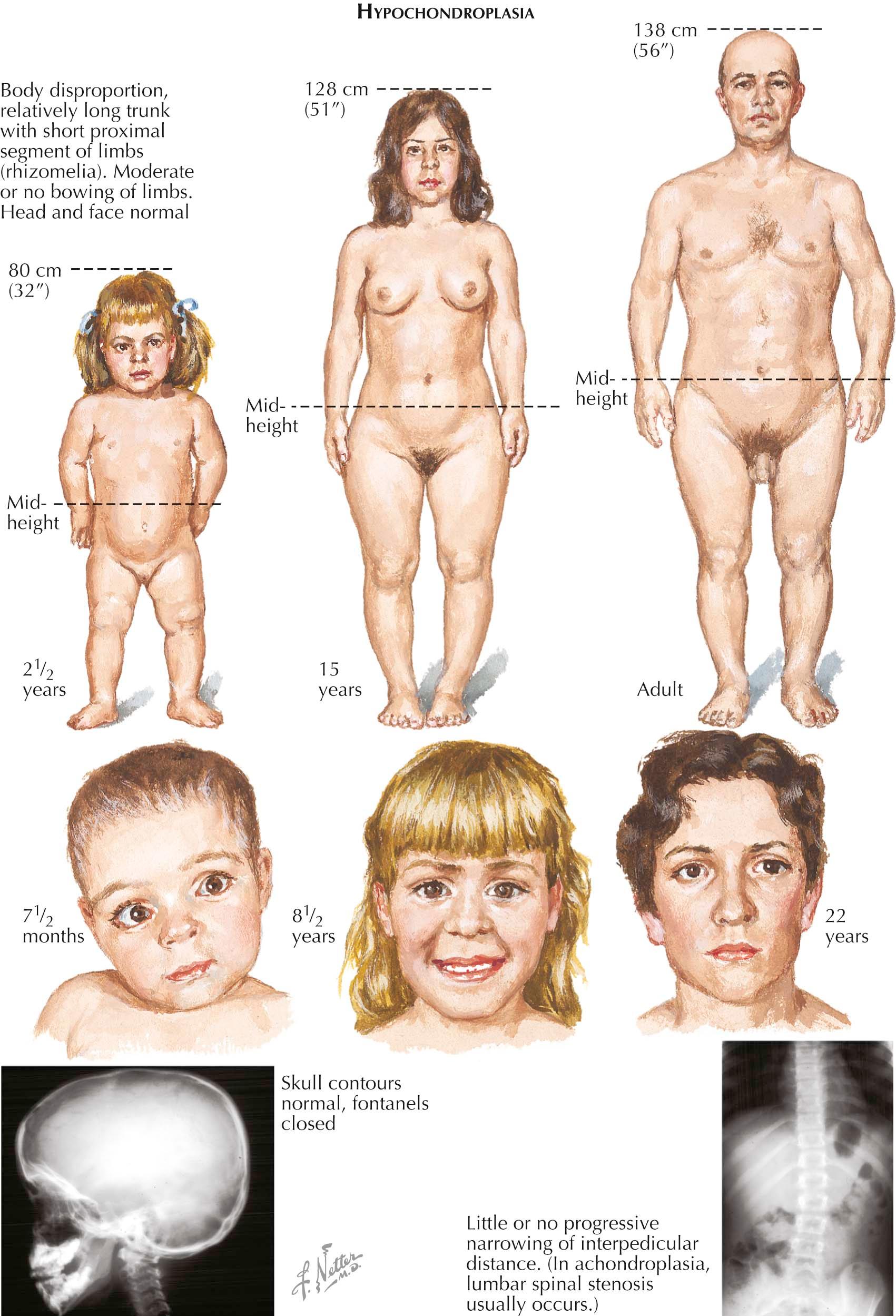
For many years, hypochondroplasia was considered a mild or atypical form of achondroplasia, and many cases are probably overlooked or misdiagnosed because the height reduction and body disproportion are often relatively mild.
Hypochondroplasia is inherited as an autosomal dominant trait, but most cases appear to be sporadic, presumably the result of a spontaneous mutation affecting FGFR-3, resulting in a milder dysplasia than achondroplasia. For unknown reasons, about 10% of patients are mentally retarded.
Clinical Manifestations. Birth weight and length may be low normal, and the short stature may not be recognized until the patient is 2 or 3 years of age. The typical appearance is a thick, stocky physique with a relatively long trunk and disproportionately short limbs, making the upper body segment longer than the lower body segment.
Head circumference is normal, although the forehead may be slightly prominent. The face is also normal with no midfacial hypoplasia or depression of the nasal bridge.
The limbs are short and stocky. Mild bowleg is common, but alignment tends to improve with age. Ligamentous laxity is usually mild, and range of motion in the elbow, especially extension and supination, is often limited. The hands are broad with short fingers but no trident formation.
The trunk commonly shows mildly exaggerated lumbar lordosis with a sacral tilt and a slightly protuberant abdomen. Aching knees, elbows, and ankles and low back pain are common in adulthood. Adult height ranges from 52 to 59 inches.
Neurologic complications, particularly compressive myelopathy or radiculopathy, are much less frequent than in achondroplasia.
Radiographic Findings. Characteristic findings permit differentiation from achondroplasia. The skull is essentially normal, except for a mild bossing of the forehead. Generalized shortening of the long bones with mild metaphyseal flaring is most notable at the knees. In children, the growth plates of the distal femurs may show a shallow, V -shaped indentation, but this is not as pronounced as the chevron-shaped notch seen in achondroplasia. The femoral necks are short and broad. The pelvis may be basically normal or mildly dysplastic (e.g., the greater sciatic notches are reduced in width and the ilia are square and shortened). In the lumbar spine, interpedicular distances lack the normal caudal widening, but these alterations are not as profound as in achondroplasia. The height of the vertebral bodies is normal, and the dorsal borders are only mildly scalloped.
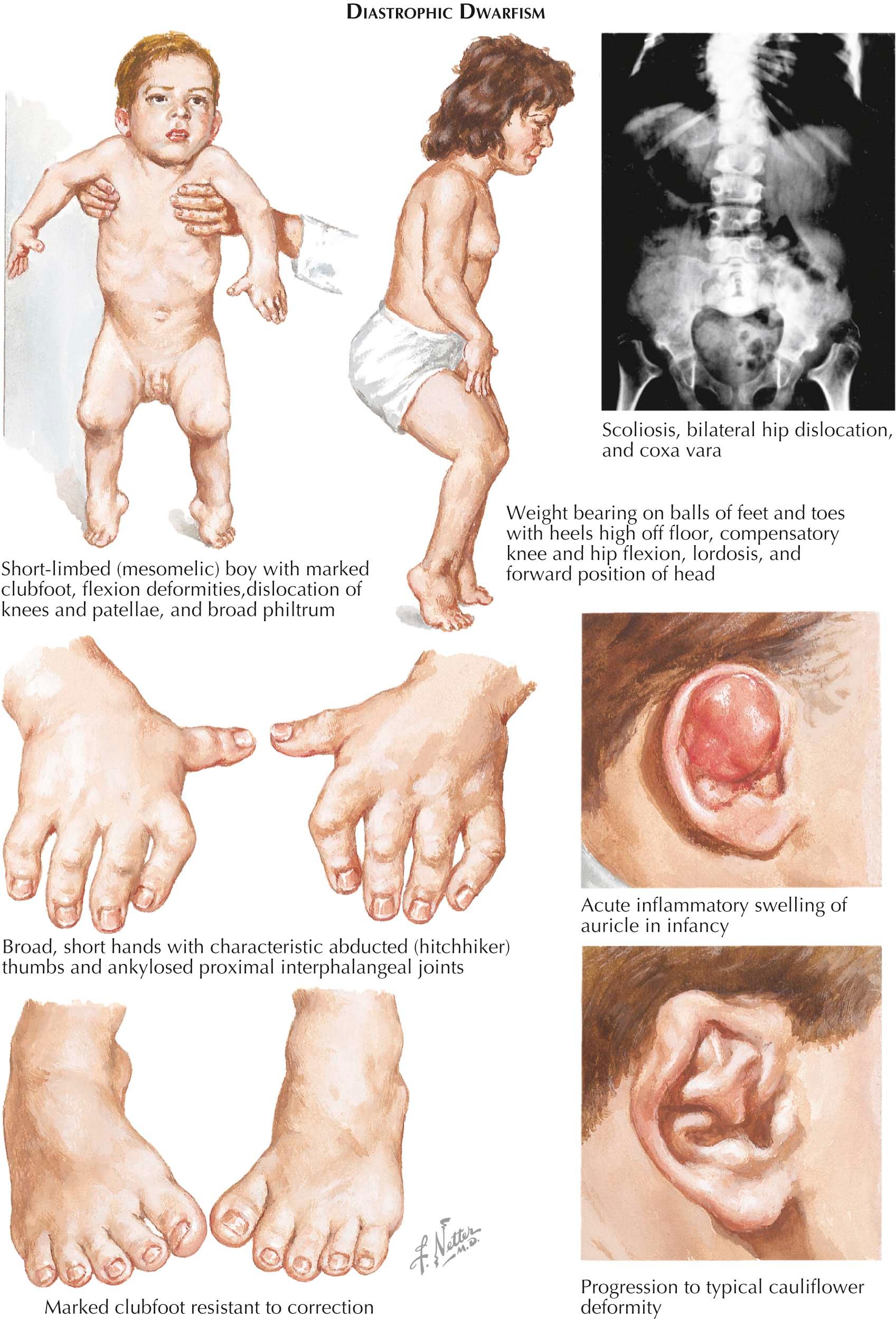
Like so many other bone dysplasias, diastrophic dwarfism, or dysplasia, was originally mistaken for a variant of achondroplasia with clubfoot or arthrogryposis multiplex congenita. The disorder is transmitted as an autosomal recessive trait affecting chromosome 5 and the diastrophic dysplasia sulfate transporter (DTDST), leading to a deficiency of the sulfate transport protein. The undersulfation of proteoglycans in the collagen matrix impairs the response of cells to fibroblast growth factor and limits endochondral growth. A lethal variant is characterized by a lower birth weight than in the classic form, radiographic evidence of overlapping joints, dislocation of the cervical spine, and congenital heart disease.
Clinical Manifestations. Clinical findings vary widely. Formerly, patients with similar but less severe signs were thought to have a variant form or a different condition. The differences, more apparent than real, were due to variable phenotypic expression.
A unique group of malformations is evident at birth, with additional characteristics appearing later. In the newborn period, the head appears normal, but many patients develop a characteristic facial appearance with a narrow root and broad midportion of the nose, long and broad lip philtrum, and square jaw. The prominent area around the mouth, coupled with the other characteristic facial features, gave rise to the now obsolete term cherub dwarf. The face is long and full with a high, broad forehead. Capillary hemangiomas are common in the midforehead but fade or disappear with age. Abnormalities of the palate are seen in 50% of patients and include complete, partial, or submucous clefts, bifid uvula, or double uvula with a median longitudinal ridge. These palatal abnormalities—and possibly laryngeal defects—produce the characteristic soft rasping or hoarse voice.
In 80% of patients, the ears swell in the first few days or weeks after birth, giving the appearance of acute inflammation. The swelling subsides spontaneously in 4 to 6 weeks, resulting in a cauliflower ear. Calcification and ossification occur later. Hearing is not affected by the small size of the external auditory canals but can be impaired by deformity of the middle ear ossicles.
Reduced height is primarily due to rhizomelic shortening of the limbs and is further augmented by flexion contractures of the joints, especially the hips and knees. Adult height ranges from 34 to 48 inches.
Partial and complete joint dislocation is also common, particularly in the shoulders, elbows, hips, and patellae. The dysplastic hip changes, coxa vara, and hip dislocation combine to produce a grossly abnormal gait.
Hand malformation is a hallmark of diastrophic dwarfism. The hypermobile thumb and deformed first metacarpal create an abducted hitchhiker position. The fingers are short and broad with ulnar deviation; there is limitation of movement due to ankyloses of the proximal interphalangeal joints (symphalangism). Severe progressive clubfoot is another characteristic.
The trunk is deformed by excessive lumbar lordosis that develops early in life. Scoliosis, which may also begin in infancy, becomes more severe with weight bearing and leads to trunk deformity and barrel chest. Kyphosis of a variable degree accompanies the scoliosis, and the resultant deformity further reduces height. Spinal changes, especially cervical kyphosis, may cause catastrophic neurologic problems.
Radiographic Findings. Characteristic signs are short, broad, long bones with flared metaphyses. Development of the epiphyses is delayed and irregular, and stippling has been observed. The epiphyses of the proximal femurs, absent at birth, are flat and distorted when ossification does occur. The epiphyses of the proximal tibias tend to be triangular and larger than those of the distal femurs. Other findings include cervical kyphosis and dysplasia; thoracolumbar kyphoscoliosis; partial or complete dislocation of the hips; precocious ossification of the costal cartilage; small, oval, or triangular first metacarpals; irregular deformity of the metacarpals, metatarsals, and phalanges; and clubfoot.
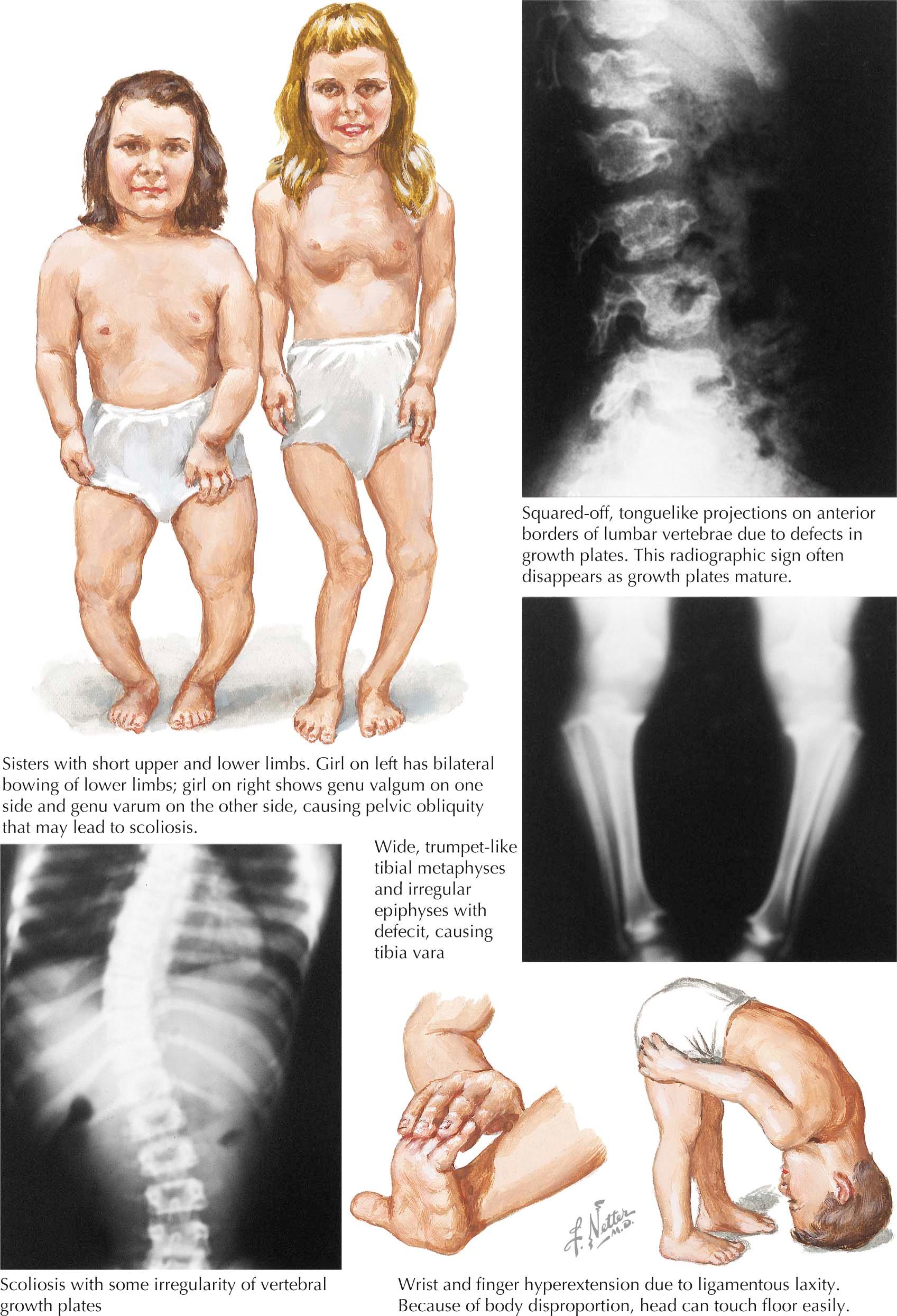
For many years, pseudoachondroplasia was confused with achondroplasia (see Plates 4-1 to 4-4 ) and Morquio syndrome (see Plate 4-18 ). Pseudoachondroplasia is most often inherited as an autosomal dominant trait affecting chromosome 19 and the cartilage oligomeric matrix protein (COMP), but a rare autosomal recessive form has also been proposed. Hyaline cartilage, fibrocartilage, and growth plate cartilage are affected. Proteoglycan abnormalities have been identified and are probably related to the core protein or enzymes responsible for the formation of the glycosaminoglycan chains in cartilage.
Clinical Manifestations. Growth retardation is usually not apparent until the child is 1 year old and often not until age 2 or 3. A delay in walking or an abnormal gait is often the first clinical clue. By this time, body measurements clearly reveal the disproportionate short stature. As the growth rate slows, the typical habitus of long trunk, exaggerated lumbar lordosis, prominent abdomen, and rhizomelic shortening of the limbs develops.
Head size and face are normal. By early childhood, the patient has a waddling gait. Malalignment of the knees develops, including bowleg, knock-knee, or windswept deformities (bowleg on one limb, knock-knee on the other). Flexion contractures develop in the hips and knees, with joint pain and precocious osteoarthritis. The hands and feet are short and stubby with considerable ligamentous laxity, particularly at the wrists and fingers. Cervical instability may also be identified. Incomplete elbow extension is typical and is related to the dysplastic bone changes rather than to soft tissue problems. Adult height ranges from 32 to 51 inches.
Radiographic Findings. The skull and facial bones are normal. The long bones in the hand appear short and stubby, and the carpals are dysplastic, with late ossification. In childhood, the small, irregular epiphyses of the femoral heads may become severely deformed and fragment by early adulthood. The ilia tend to be large and straight sided, whereas the pubic and ischial bones are short and broad; the greater sciatic notches are smaller than normal.
Spinal changes in childhood include moderate flattening of the vertebral bodies (platyspondyly) with biconvex deformity and irregularity of the superior and inferior growth plates, producing a tonguelike projection apparent on the lateral view. By adolescence, most of these characteristic vertebral changes disappear and only mild platyspondyly persists. Scoliosis and excessive lumbar lordosis may also be evident.
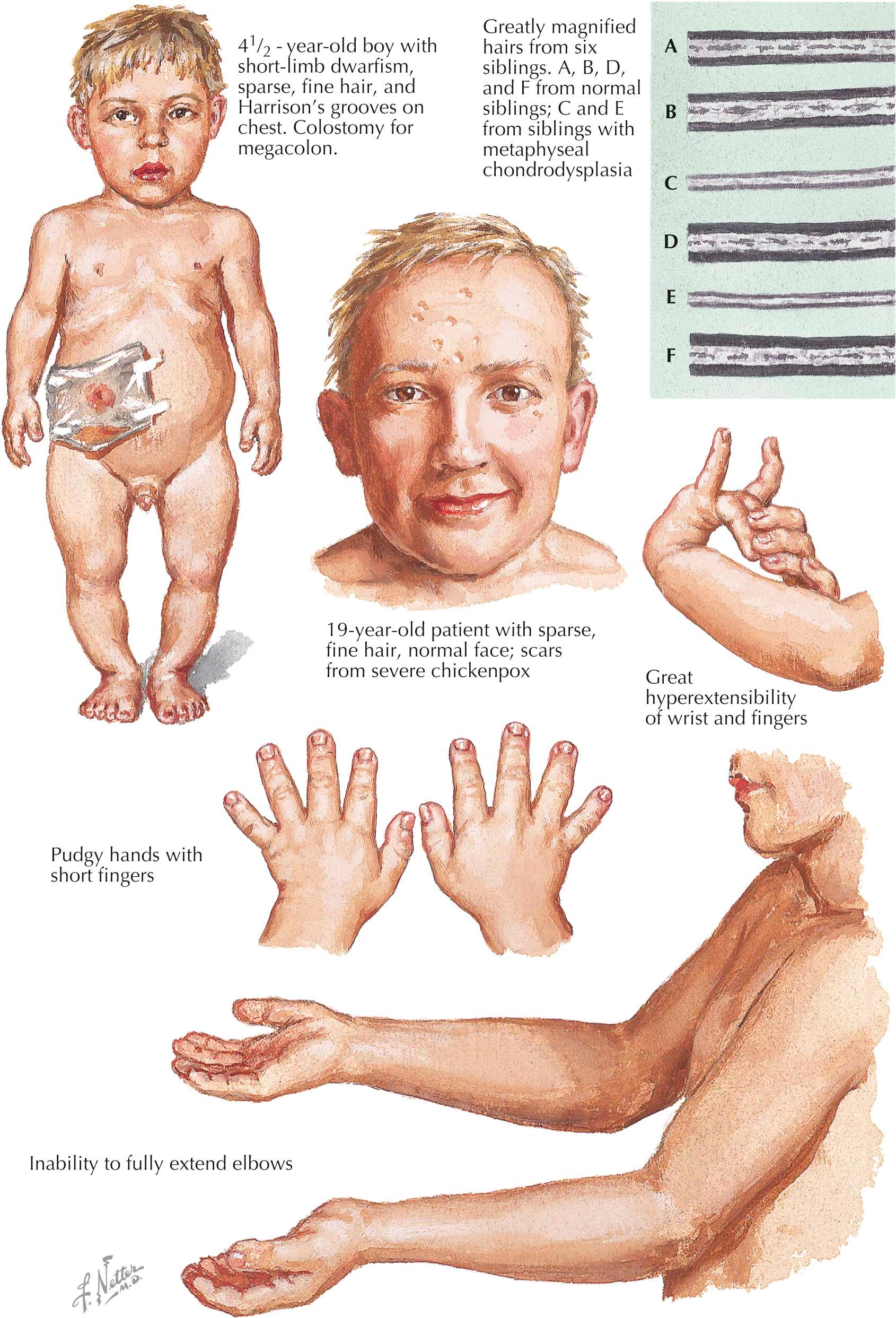
Commonly known as cartilage-hair hypoplasia, this disorder belongs to a group of intrinsic bone dysplasias characterized by significant changes in the metaphyses of the long bones and hair of small diameter. It is transmitted as an autosomal recessive trait and is relatively common in Finland and among the Old Order Amish in Pennsylvania. The genetic defect is in the ribonuclease of mitochondrial RNA-processing gene (RMPR) located in chromosome 9. At times this is due to uniparental disomy, in which the child inherits two copies of a chromosome from one parent.
Clinical Manifestations. At birth, weight is normal but body length is reduced. The configuration of the head and face is normal. The elbows do not extend fully. The excessive length of the distal fibulas in relation to the short tibias results in ankle deformity, and unilateral bowleg or knock-knee may develop in childhood. The hands and feet are short and pudgy; the foreshortened nails are normal in width and grow normally. Ligamentous laxity of the fingers and toes permits extraordinary hypermobility in the joints. Atlantoaxial instability and odontoid hypoplasia are common. A prominent sternum and mild flaring of the lower ribs with Harrison's grooves are also typical. In many patients, a distinctive feature is the sparse, fine, light-colored hair, which grows slowly and breaks easily. Cross-sectional microscopic examination reveals a reduced, somewhat elliptic hair shaft of small diameter that frequently lacks a pigment core. Body hair is similarly affected. However, in some patients, the hair is nearly normal.
About 10% of patients with the McKusick-type metaphyseal chondrodysplasia manifest intestinal malabsorption and Hirschsprung disease. They may be unusually susceptible to chickenpox. Neutropenia, persistent lymphopenia, normal serum immunoglobulins, and diminished delayed skin hypersensitivity may also be present. Adult height ranges from 41 to 57 inches.
Radiographic Findings. Radiographic abnormalities do not become evident until the patient is 9 to 12 months old. Although changes are seen primarily in the limbs and ribs and around the knees (where they are most severe), subtle changes occur in other bones such as the vertebrae and pelvic bones. The metaphyses are widened and irregular with sclerosis and cystic alterations. Other findings include cupping of the ribs and ankle deformity.
Histologic Findings. Microscopic examination of the metaphysis shows normal ossification but a hypoplastic cartilage. Chondrocytes are decreased in number, and columnization is disorganized. The cartilaginous cores on which bone mineral can deposit appear to be inadequate.
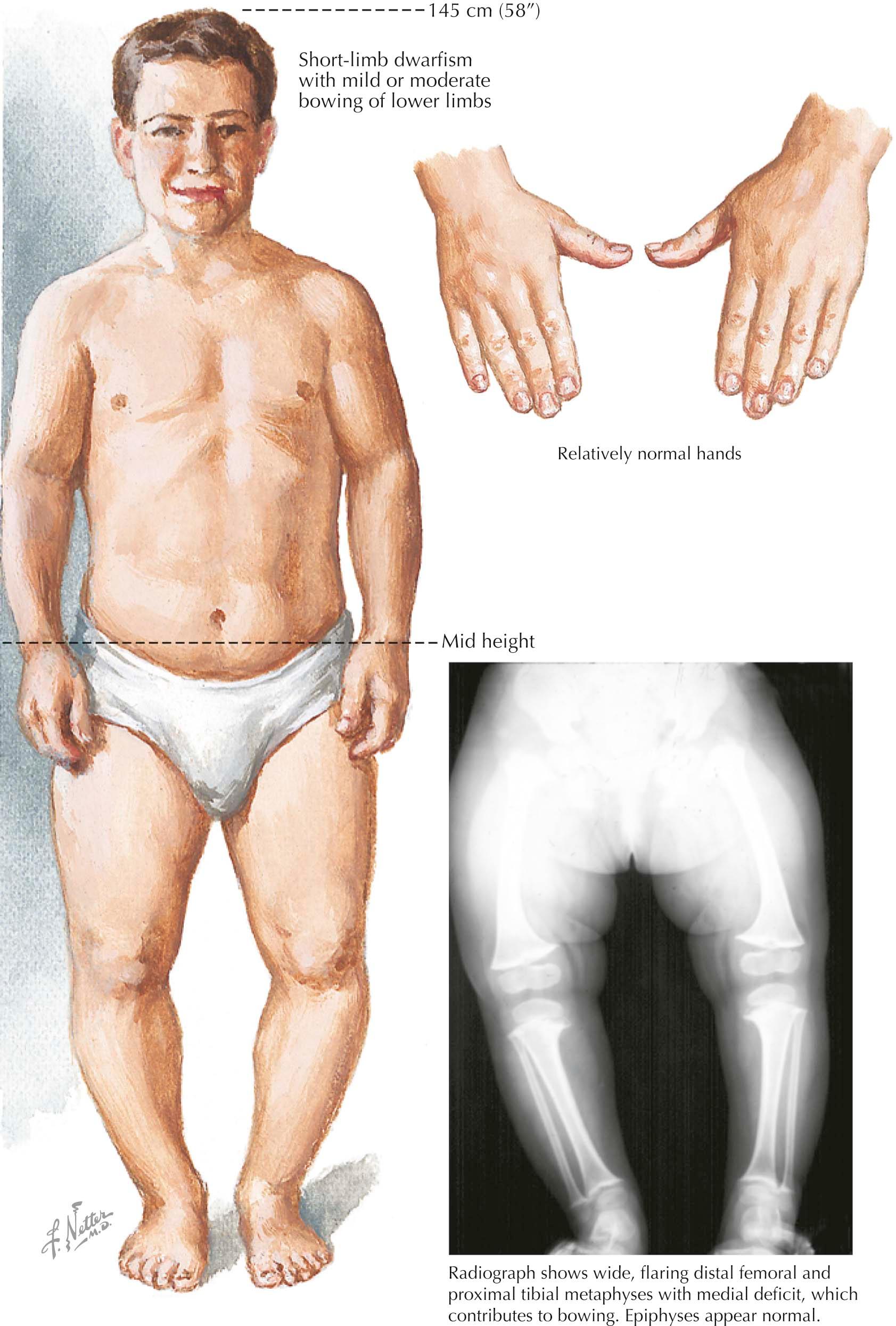
In 1949, Schmid described a form of metaphyseal chondrodysplasia that has been known by many names, including metaphyseal dysostosis and familial bone disease resembling rickets. The Schmid-type metaphyseal chondrodysplasia is transmitted as an autosomal dominant trait affecting chromosome 6 and type X collagen with variable expressivity; females are usually less severely affected. Sporadic cases may be linked to advanced paternal age.
Clinical Manifestations. The moderately short stature of the short-limb type is evident by 18 to 24 months of age. The head and face are not affected. The wrists are prominent or enlarged, and often the fingers do not extend fully. Bowleg, commonly the first sign, becomes obvious shortly after the child begins to walk; if severe, the bowing produces a waddling gait and contributes to the height reduction. Poor alignment of the lower limbs can lead to symptomatic osteoarthritis in the hips and knees. Flaring of the lower rib cage signals trunk involvement, and the general habitus is stocky or chubby. Adult height is 51 to 63 inches.
Radiographic Findings. Metaphyseal abnormalities vary from mild scalloping to gross irregularities in the ankles, knees, wrists, shoulders, and hips. Although metaphyseal lesions appear to heal with bed rest, they recur once weight bearing is resumed. The epiphyseal lines are wide, and epiphyseal ossification centers appear normal.
Coxa vara and bowleg are common, and the long bones and femoral necks are short. The acetabular portions of the ilia tend to be broad, and the acetabular roof, which is normally vertical, is horizontal. Long bones in the hand and foot are mildly to moderately shortened, but metaphyseal changes are minor or absent.
Differential Diagnosis. This type of metaphyseal chondrodysplasia has frequently been confused with vitamin D–resistant rickets. Clinical and radiographic findings are quite similar. However, vitamin D–resistant rickets has an X-linked dominant inheritance, whereas the Schmid-type metaphyseal chondrodysplasia is transmitted as an autosomal dominant trait. Unlike vitamin D–resistant rickets, there are no characteristic biochemical changes (serum calcium, phosphate, and alkaline phosphatase levels are normal) and no beneficial response to administration of vitamin D.
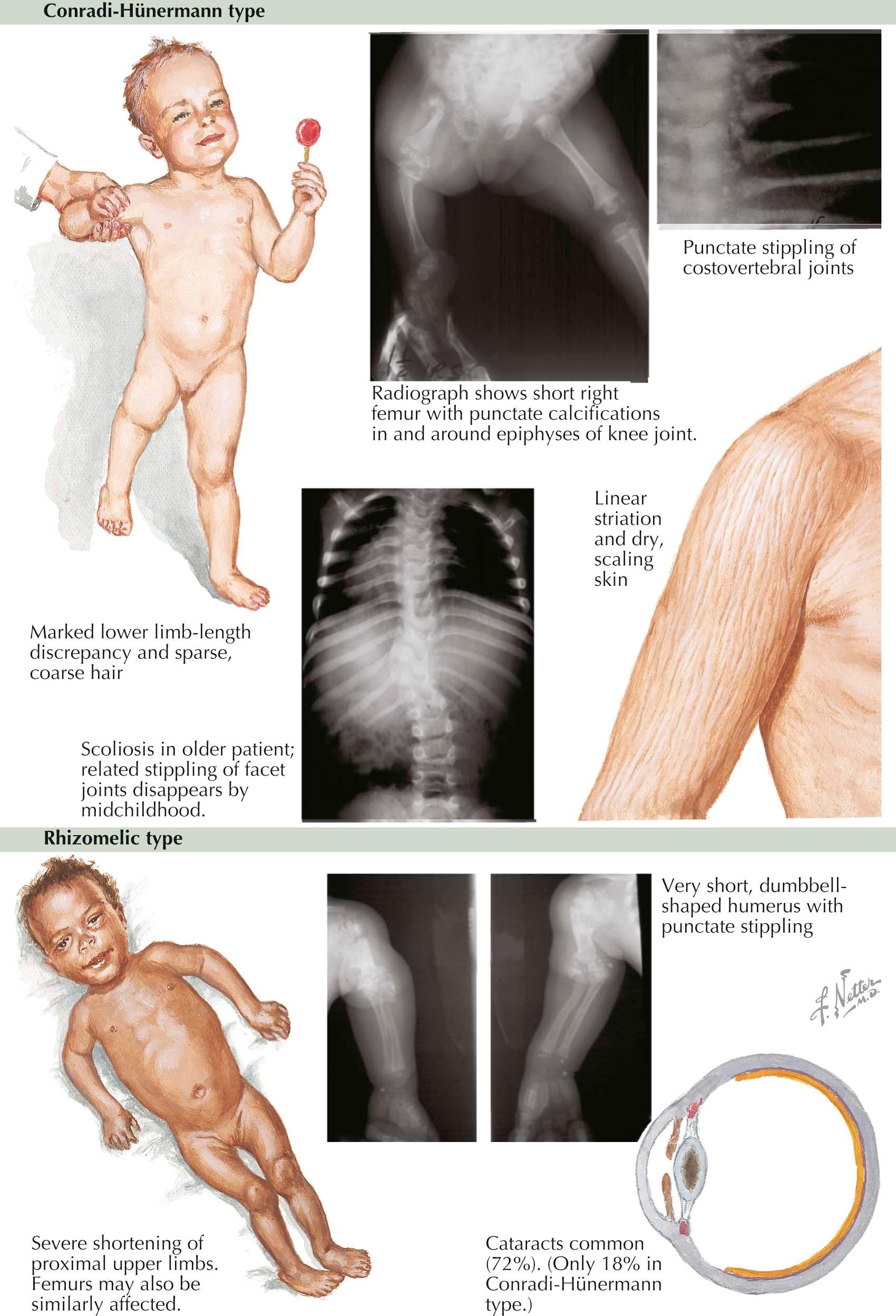
Chondrodysplasia punctata has been known by a bewildering array of names including chondrodystrophia calcificans congenita, Conradi-Hünermann disease, and dysplasia epiphysealis punctata. Although it is commonly considered a discrete entity characterized by radiographic evidence of punctate epiphyseal and extraepiphyseal calcifications (stippling) in childhood, this form of intrinsic bone dysplasia actually has nonosseous manifestations. To complicate the diagnosis further, epiphyseal stippling is seen in a number of unrelated disorders, including cerebrohepatorenal syndrome, generalized gangliosidosis, cretinism, Smith-Lemli-Opitz syndrome, Down syndrome (trisomy 21), and anencephaly.
In genetic counseling, it is important to distinguish this autosomal dominant type from the clinically similar X-linked dominant type, which is fatal in hemizygous males. Severely affected infants are either stillborn or die soon after birth. Prognosis for survival is relatively good for those less severely affected. The Conradi-Hünermann type is X-linked recessive affecting Xp22 and the arylsulfatase E (ARSE) gene.
Clinical Manifestations. The major signs are usually evident at birth: a head of average circumference with a distinctive flat facies, mildly flattened nasal bridge, relatively short neck, and asymmetric shortening of the limbs. By early childhood, the characteristic facies largely disappears but the limb asymmetry may need surgical correction. Congenital cataracts are seen in about 18% of cases. Scoliosis is common after age 1; joint contractures occur later. The skin is often dry, scaly, and atrophic. The ichthyosiform skin changes and alopecia usually persist into adulthood. Adult height is 51 to 63 inches.
Radiographic Findings. Early signs consist of punctate calcifications in the vertebral column and the epiphyses of the long bones and the carpal, tarsal, and pelvic bones, usually in asymmetric distribution. The metaphyses are intact, but the epiphyses frequently become dysplastic (flattened, small, or irregularly shaped).
Rhizomelic-type chondrodysplasia punctata has an autosomal recessive inheritance and is more severe than the Conradi-Hünermann or X-linked dominant type. The PEX7 gene is affected, which encodes the protein peroxin 7. Recurrent infections usually cause death in the first year of life. Survivors have a high incidence of profound psychomotor retardation and other neurologic abnormalities, such as spastic quadriparesis.
Clinical Manifestations. The features of rhizomelic-type chondrodysplasia punctata are the same as those of the Conradi-Hünermann type, but the rhizomelic shortening of the limbs is more severe and congenital cataracts are extremely common. Microcephaly, contractures, and postnatal failure to thrive are also typical.
Radiographic Findings. The epiphyseal and extraepiphyseal calcifications are usually severe, with a symmetric distribution sparing the vertebral column. Lateral radiographs reveal vertical coronal clefts of the vertebral bodies. In the humerus and/or femur, severe shortening, splaying, and metaphyseal cupping are characteristic.
Approximately 25% of reported cases of chondrodysplasia punctata are probably transmitted as an X-linked dominant trait. This results in a mutation in the emopamil-binding protein and alters the effects on the cholesterol biosynthesis pathway. Most patients are female, and the disorder is usually fatal in males.
Clinical Manifestations. This disorder shares many features with the Conradi-Hünermann type, with hypoplasia of the distal phalanges a distinctive trait. Pathognomonic cutaneous findings in the first months of life include erythematous skin changes and striated ichthyosiform hyperkeratosis. Patterned ichthyosis, coarse and lusterless hair, and cicatricial alopecia become evident later. A variable severity, marked asymmetry of long bones, and cataracts are thought to be consistent with functional X-chromosome mosaicism in females.
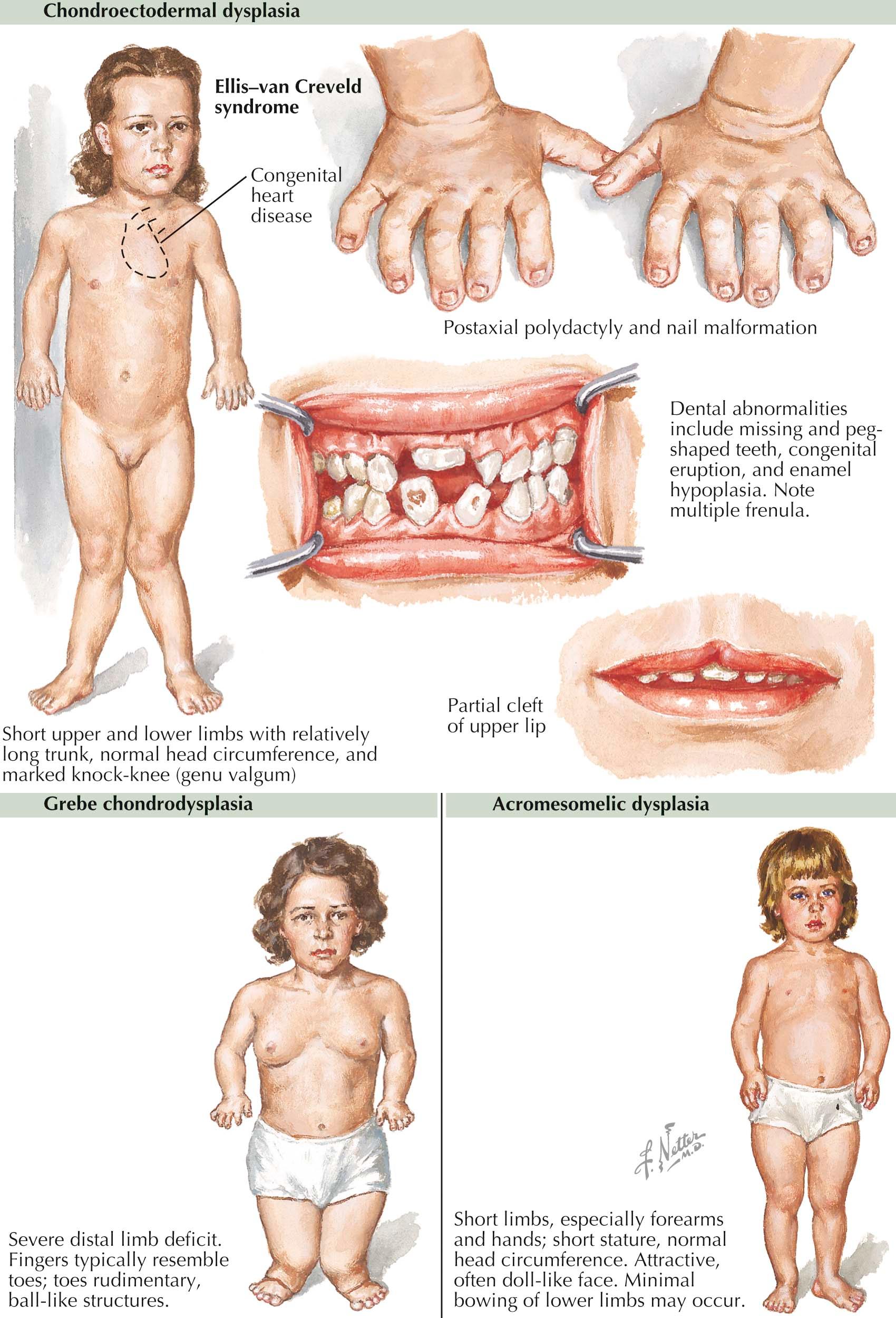
This very rare type of short-limb dwarfism has an autosomal recessive mode of inheritance with a link to chromosome 4p16.1. It is characterized by chondrodysplasia; polydactyly; ectodermal dysplasia of hair, teeth, and nails; and congenital heart defects.
Clinical Manifestations. At birth, the head and face are normal but oral and dental abnormalities are common, including natal teeth, multiple frenula that obliterate the buccolabial sulcus, and partial or pseudocleft in the midline of the upper lip. Precocious exfoliation and missing or peg-shaped teeth are evident later. Mesomelic and acromelic limb shortening is greater in the lower limbs and, with growth, knock-knee becomes serious enough to require surgical treatment. The hands are short and stubby with postaxial polydactyly, which also occurs in the feet in 10% of patients. The fingernails and toenails are hypoplastic or dysplastic. The trunk is not affected. Adult height varies from 42 to 60 inches. Congenital heart disease, typically an atrial septal defect, is seen in more than 50% of patients.
Radiographic Findings. The long bones show a progressive distal shortening with broadened metaphyses. In the hands, the capitate and hamate are fused or deformed. Delayed ossification of the lateral portions of the epiphyses and metaphyses of the proximal tibias results in knock-knee. The pelvis has short iliac crests and, in infancy, spurlike inferior projections from the medial and lateral margins of the acetabula. The configuration of the pelvis becomes normal by late childhood.
The rare Grebe chondrodysplasia is transmitted as an autosomal recessive trait. Mild shortness of the hands and feet may be an indicator of the carrier state (heterozygosity). Although stillbirth is frequent and neonatal mortality high, after infancy the prognosis for survival is good.
Clinical Manifestations. Marked shortening of both upper and lower limbs is apparent at birth. The legs are more affected than the arms, and length reduction of the long bones increases progressively from the proximal to the distal segments. The fingers are extremely short and toelike. In the short, valgus feet, the toes may be rudimentary, ball-like structures. Polydactyly occurs in 50% of patients. Adult height is only 39 to 41 inches.
Radiographic Findings. The skull and axial skeleton appear essentially normal. The limbs, however, show severe dysplasia or aplasia of all bony elements.
Transmitted as an autosomal recessive trait, acromesomelic dysplasia results in severely restricted growth.
Clinical Manifestations. This short-limb form of dwarfism is usually apparent in the first few weeks or months of life. Head size is normal, but the frontal bones may be prominent and the midface mildly hypoplastic and flattened. Limb shortening is greatest in the middle or distal segments. Range of motion of the elbow joints is limited by partial dislocation of the radial heads. The forearms are often bowed. Fingers, toes, and nails are very short. The thorax is small with mild anterior flaring of the lower ribs. Exaggerated lumbar lordosis makes the buttocks prominent; lower thoracic kyphosis is also common. Adult height ranges from 38 to 48 inches.
Radiographic Findings. Radiographs reveal a progressive shortening of the long bones, bowing of the radii, and often subluxation of the radial head. The epiphyses are relatively normal in infancy and become cone shaped later. The hands are unusually squat, and the phalanges appear square or sugarloaf shaped. The height of the vertebral bodies is minimally reduced, primarily in the posterior portions.
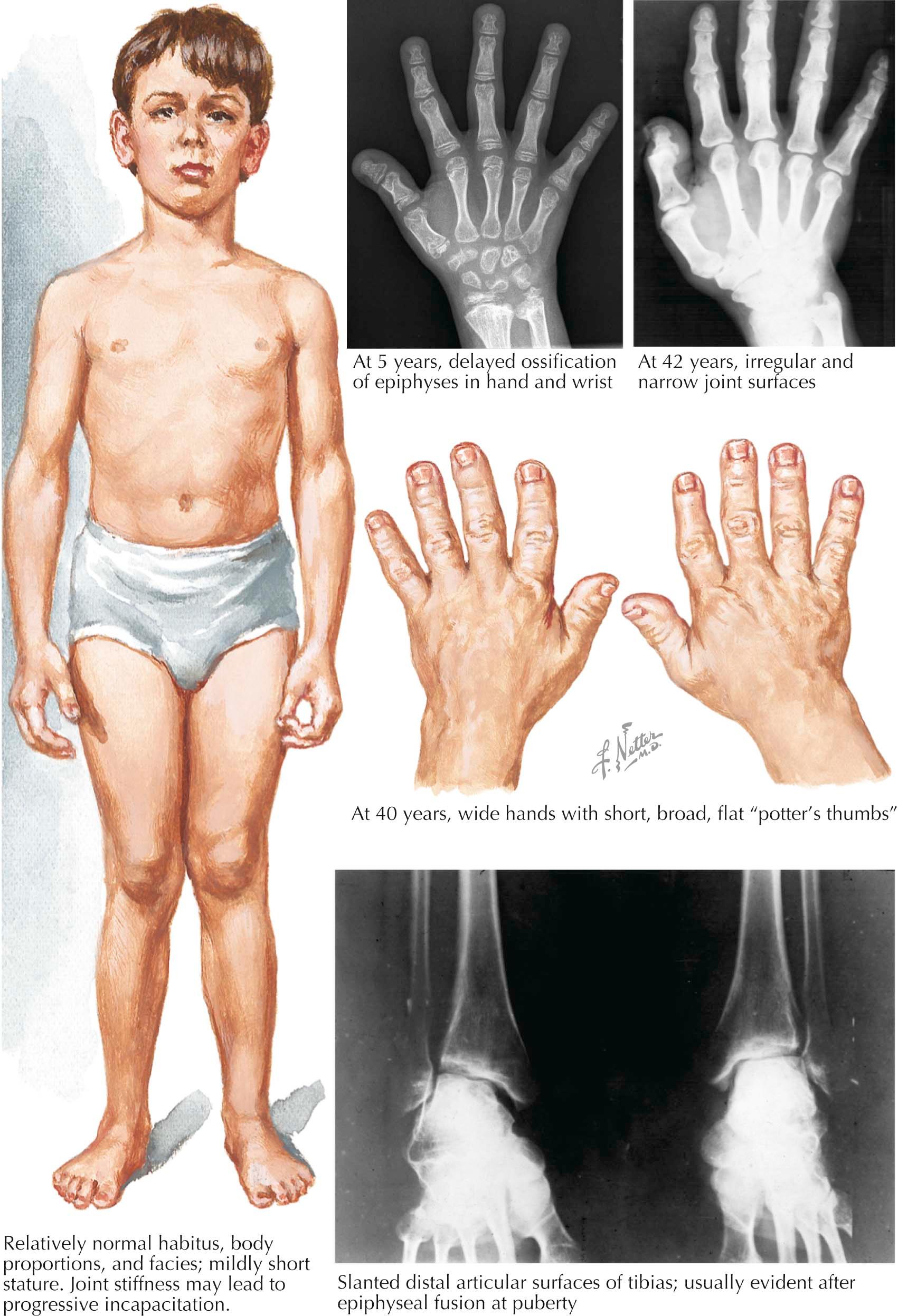
Multiple epiphyseal dysplasia, Fairbank type, refers to a group of disorders with variable clinical and radiographic signs affecting the formation and maturation of the epiphyses. Usually an autosomal dominant trait, it can also be transmitted as an autosomal recessive trait. Different factors have been involved, including chromosome 19 and COMP, chromosome 1 and type IX collagen, and the gene encoding for matrillin-3, which is an extracellular matrix protein.
Clinical Manifestations. Multiple epiphyseal dysplasia usually remains unrecognized until the child is 5 to 10 years of age. The hands sometimes appear short and stubby, especially the thumbs. The shortening in the limbs is variable, and the trunk is normal.
Symptoms include morning stiffness, difficulty in running or climbing stairs, and a waddling gait. Joint discomfort, pain, and stiffness also develop, especially in the lower limbs. At first, symptoms tend to be episodic, transient, and fluctuating, but the waddling gait becomes more pronounced as the disorder progresses, and increased discomfort and stiffness force patients to limit their activities. Severe osteoarthritis of the hips often develops in older patients. Some affected persons, however, remain asymptomatic. Adult height ranges from 54 to 61 inches.
Radiographic Findings. Accurate diagnosis requires radiographic examination of the entire skeleton. Bilateral epiphyseal abnormalities, primarily in the hips, knees, and ankles, are the chief manifestations. The ossification centers of the epiphyses appear late, and fusion with the bone shaft is late. The epiphyses are irregular and flattened, and the ossification centers may be mottled with secondary centers, but there is no true stippling.
Mild shortening of the long bones develops, and metaphyseal irregularity is minimal. A deficiency in the lateral portion of the epiphyses of the distal tibias produces a sloping, wedge-shaped distal articular surface, which is an important diagnostic sign in adults. Bipartite patella (double layer patella) is a common finding. Short, stubby phalanges and metacarpals with epiphyseal irregularities are seen. Vertebral changes are minimal and are usually manifested as Schmorl's nodules or mild anterior wedging of the vertebral bodies in the thoracolumbar area.
Differential Diagnosis. Multiple epiphyseal dysplasia is often mistakenly diagnosed as bilateral Legg-Calvé-Perthes disease. Family history, bone scans, and a radiographic survey of the entire skeleton help distinguish the two conditions. In patients with multiple epiphyseal dysplasia, the epiphyses of the femoral heads are symmetrically affected, unlike the asymmetric involvement that characterizes Legg-Calvé-Perthes disease; multiple epiphyseal dysplasia is also found in other parts of the skeleton.
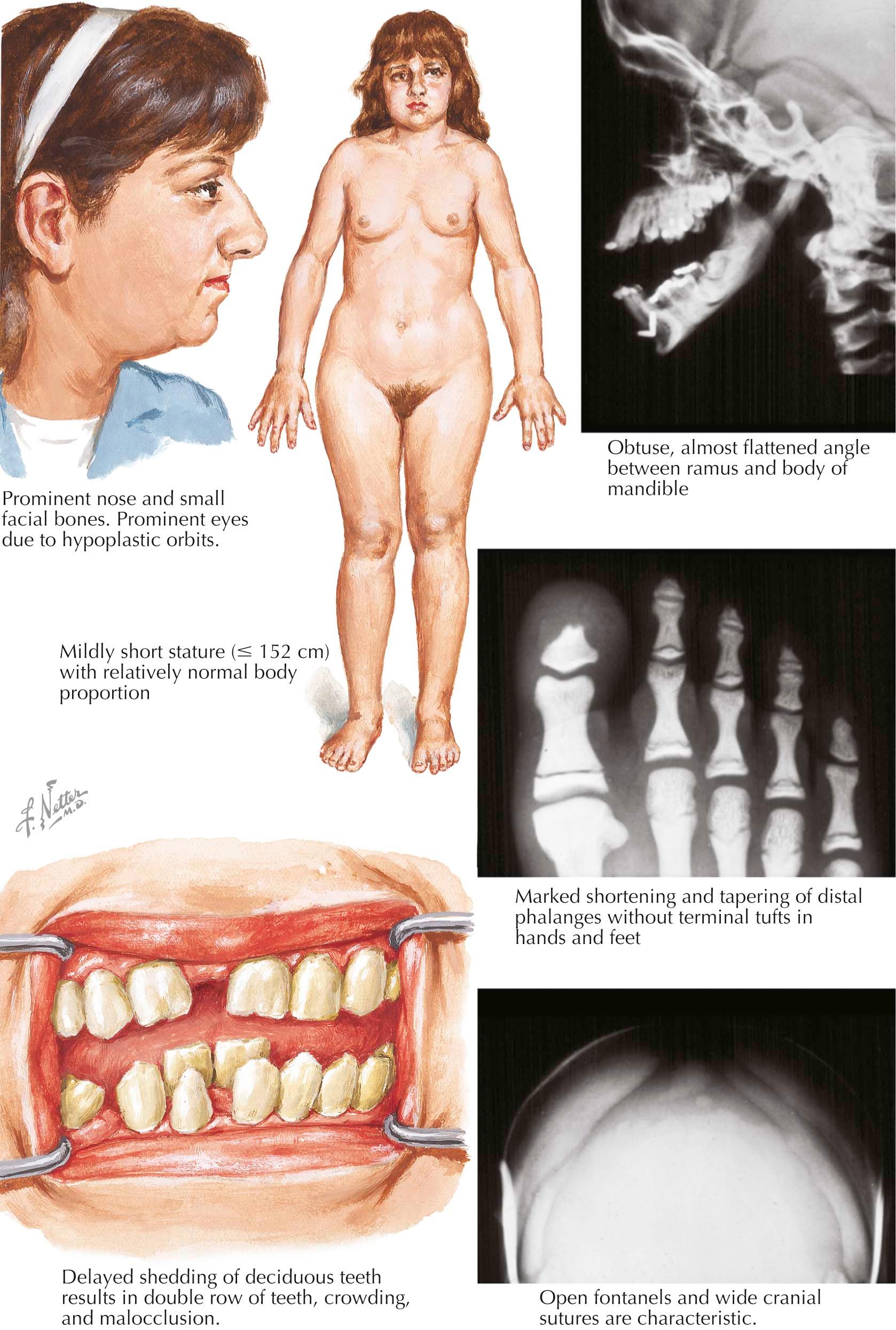
Pycnodysostosis was once thought to be achondroplasia with cleidocranial dysostosis. Parental consanguinity has been implicated in more than 30% of cases of this autosomal recessive disease. The locus has been mapped to chromosome 1q21. Mutations lead to cathepsin K deficiency, which leads to diminished osteoclast function. Mental retardation occurs in about one sixth of patients.
Clinical Manifestations. The major signs are failure to thrive, with resultant short stature in infancy and persistence of an open anterior fontanel even into adulthood.
The head is large in relation to the body, with protrusion of the frontal and occipital bones. The major cranial sutures and anterior fontanel often remain open, giving the impression of hydrocephalus. The face is small in proportion to the cranium and is characterized by bulging or prominent eyes, parrot-like nose, receding chin, and an obtuse angle of the jaw. Dental anomalies include premature or delayed eruption of teeth, persistence of the deciduous dentition, malocclusion, and hypoplasia of the enamel. The vault of the palate is highly arched and sometimes deeply grooved. The sclerae may be blue.
Because of increased bone density, even such mild trauma as tooth extraction can cause fractures. Deformities of the long bones, often due to fractures and malunion, may exacerbate the short-limb dwarfism. Arm span tends to be less than normal, and the terminal phalanges of the fingers are short and wide. Kyphosis, scoliosis, and exaggerated lumbar lordosis may develop. In some patients, the thorax is narrow and long. Adult height varies from 51 to 59 inches.
Radiographic Findings. Sclerosis is seen throughout the skeleton. The cranium is large, shortened, and brachycephalic with separation of sutures and an open anterior fontanel. Multiple sutural (wormian) bones are often present, and the facial bones, particularly the jaw, are underdeveloped. There is variable cortical thickening of the long bones with moderate metaphyseal undermodeling, with or without evidence of fractures. In the hands and feet, partial aplasia of the tufts and distal portions of the phalanges creates a bizarre drumstick appearance on radiographs. The acromial ends of the clavicles are dysplastic and hypoplastic.
Differential Diagnosis. Pycnodysostosis is easily distinguished from cleidocranial dysostosis (see Plate 4-28 ) and osteopetrosis (see Plate 4-26 ).
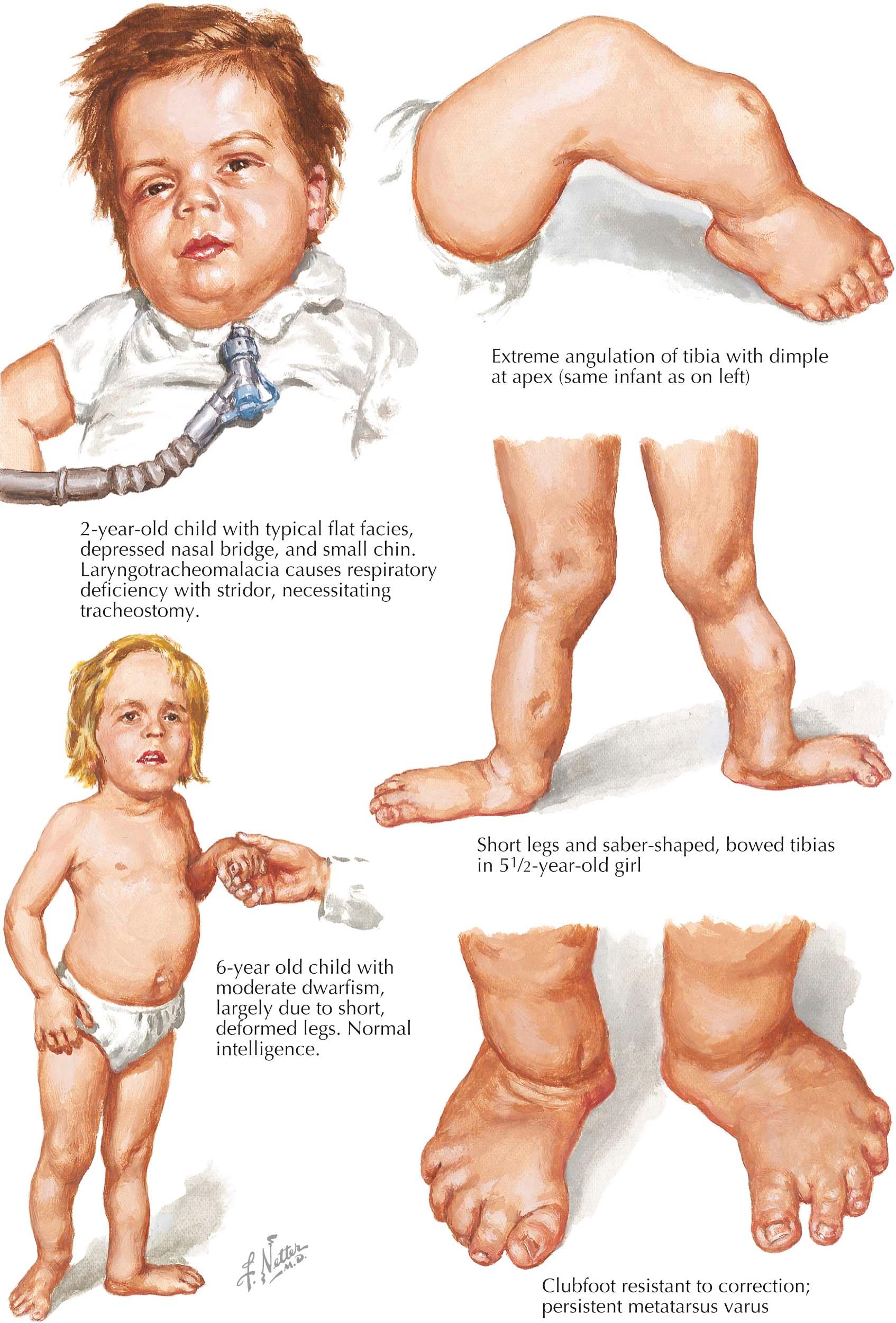
A rare form of congenital short-limb dwarfism, camptomelic dysplasia is characterized by prenatal bowing of the long bones of the lower limbs in association with anomalies of other organs. However, although bowing of the limbs is common, it is not always present or pathognomonic.
The disorder is an autosomal recessive trait, although there may be other modes of inheritance. Camptomelic dysplasia is in some cases associated with XY sex reversal. The majority of infants born with camptomelic dysplasia appear to be female, but genetic studies show that many are actually male with XY gonadal dysgenesis.
In one third of cases, hydramnios is detected during pregnancy. Stillbirth is common, and many liveborn infants die in the neonatal period or live for only several months; many develop severe respiratory distress, in part related to hypoplasia and other abnormalities of the tracheobronchial tree.
Although prognosis is guarded during the first year of life, with medical intervention, more and more children with camptomelic dysplasia survive into young adulthood.
Clinical Manifestations. At birth, infants have a low-normal weight, a relatively large and long (dolichocephalic) head, and disproportionate short length, primarily in the lower limbs.
The prominent forehead, rather flat face, depressed nasal bridge, long philtrum, small mouth, small jaw (micrognathia), and occasionally wide-set eyes and low-set ears produce a characteristic facies. Cleft palate occurs in most patients.
The arms are normal or only slightly shortened and bowed. The tibias are often bent, or boomerang shaped, with a cutaneous dimple over the apex of the bend. The femurs tend to be anterolaterally bowed, and clubfoot is common. The thorax is often small, narrow, and bell shaped. Progressive scoliosis is common. Hypotonia is an additional feature.
Stridor and laryngotracheomalacia are major hazards in infancy, leading to long-term episodes of apnea, pulmonary aspiration, cyanosis, respiratory failure, seizures, and feeding difficulties. Tracheostomy and ventilatory assistance are frequently necessary for long periods of time. Congenital heart disease is found in nearly 25% of patients and hydronephrosis in 38%. Hemorrhagic phenomena in the central nervous system, hydrocephalus, and absence or hypoplasia of olfactory bulbs or tracts occur in 20% of patients.
Radiographic Findings. The typical findings reflect the three phenotypes: (I) classic (long-limb) type, characterized by bowed long bones with normal caliber and moderate shortening; (II) short-limb type, marked by severely shortened and bowed long bones and essentially normal neurocranium; and (III) short-limb type, associated with premature closure of cranial sutures (craniosynostosis).
Common to all three types are a large skullcap (calvaria) in relation to facial size; a small, bell-shaped thorax with thin, wavy ribs; slender clavicles; and small scapulas. The femurs and tibias show variable degrees of bowing, and the fibulas are hypoplastic. Congenital dislocation of the hips is common. The pelvis is narrow with dysplastic pubic rami, and the ischia appear vertical or even divergent. Scoliosis or kyphoscoliosis occurs frequently.
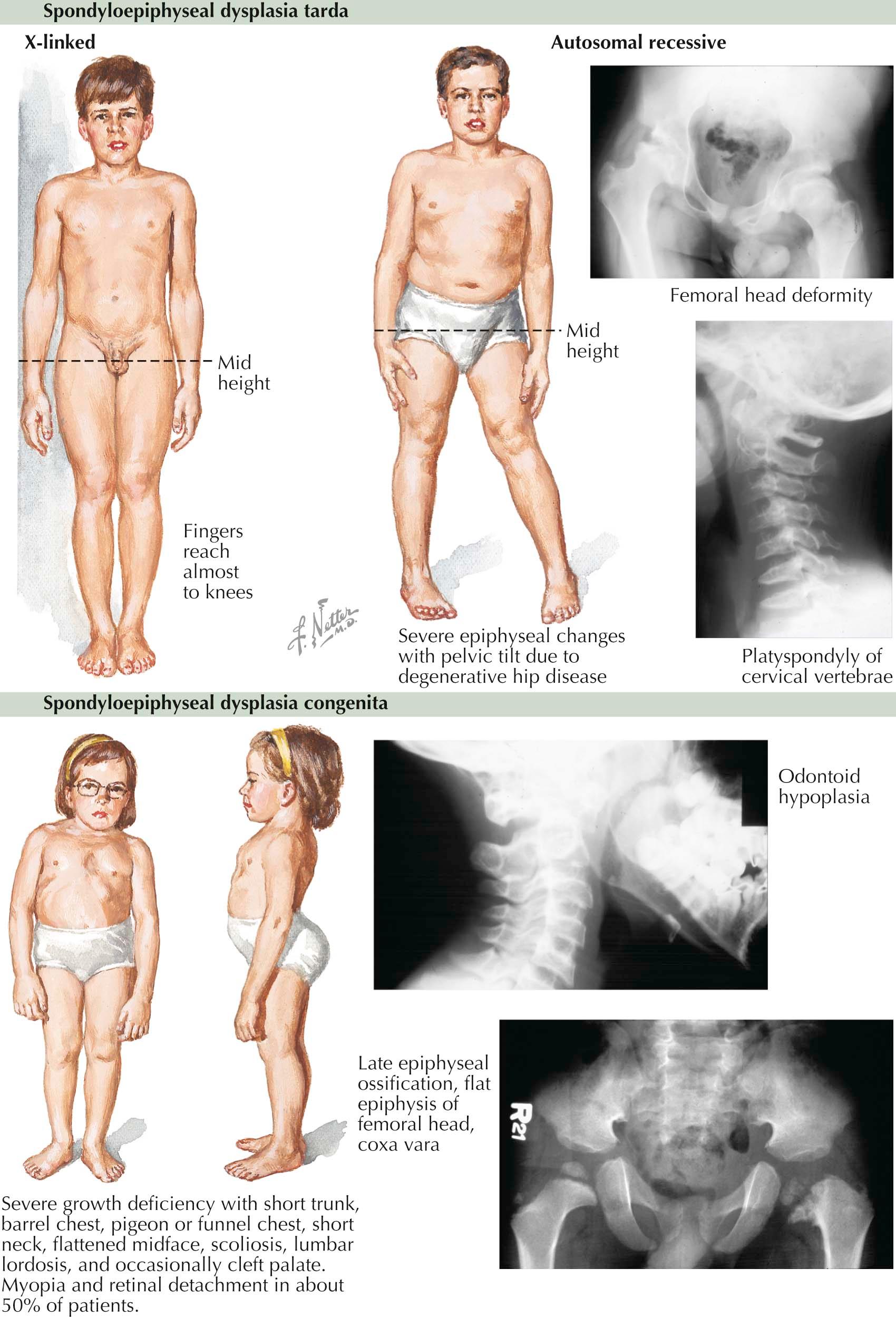
This group of intrinsic bone dysplasias is characterized by progressive abnormalities of spinal and epiphyseal development. The disorders must be differentiated from spondylometaphyseal and spondyloepimetaphyseal dysplasias, which primarily involve the metaphyses instead of, or in addition to, the epiphyses.
Although most cases of spondyloepiphyseal dysplasia tarda have an X-linked recessive mode of inheritance, both autosomal dominant and autosomal recessive forms are also known. This has been mapped to the SEDL gene in the Xp22 chromosome affecting the protein sedlin, which plays an important role in endoplasmic reticulum/Golgi vesicular transport.
Clinical Manifestations. Growth failure does not become evident until 5 to 10 years of age. The height reduction, which is primarily due to trunk shortening, becomes quite obvious by adolescence. At this time, patients complain of pain and stiffness in the back or hips. Secondary osteoarthritis of the hip is common and may become disabling. The chest is broad or barrel shaped. Adult height ranges from 52 to 61 inches.
Radiographic Findings. The distinctive configuration of the vertebral bodies is most evident in the adult lumbar spine. Initially, the vertebral bodies are mildly flattened (platyspondyly) with a hump-shaped accumulation of bone in the posterior and central portions of the cartilage ring apophysis; the disc space appears narrowed. The thoracic cage is broad, while the pelvis is small and deep. The epiphyses of the long bones show variable dysplastic changes, and osteoarthritis of the hips is evident.
Spondyloepiphyseal dysplasia congenita is the more severe form affecting the spine and epiphyses of long bones. Most cases of spondyloepiphyseal dysplasia congenita are a result of spontaneous mutation. This type of short-trunk dwarfism is typically transmitted as an autosomal dominant trait, although cases of autosomal recessive inheritance are known. Mutations to COL2A1 locus on chromosome 12 lead to abnormal type II collagen.
Clinical Manifestations. In the newborn, a broad or barrel chest, deep Harrison's grooves, and pigeon chest suggest the diagnosis. Flat, dishlike facies, cleft palate, and wide-set eyes are other early signs. In older children, the short neck makes the normal-sized head appear to rest directly on the shoulders. Myopia and retinal detachment or degeneration is occasionally seen.
The limbs show mild rhizomelic shortening but are long in comparison with the trunk; the hands and feet are essentially normal. Ligamentous laxity is excessive. Marked lumbar lordosis and moderate kyphoscoliosis occur in late childhood or early adulthood. Adults reach a height of only 33 to 52 inches.
Motor development is often delayed. In 50% of patients, hypotonia, ligamentous laxity, and odontoid hypoplasia result in atlantoaxial instability leading to spinal cord compression, which first manifests as overwhelming fatigue and decreased endurance.
Radiographic Findings. Retarded ossification of the pubic bones, femoral heads, and epiphyses of the knees, calcanei, and tali is the major feature in young children. Early in life, the vertebral bodies are ovoid or pear shaped but become flattened and irregular with time, resulting in kyphoscoliosis. Careful radiographic evaluation of the cervical spine is important because of the hazards associated with odontoid hypoplasia. Coxa vara is common, and rhizomelic shortening of the long bones with minimal dysplastic changes in the hands and feet may also be seen.
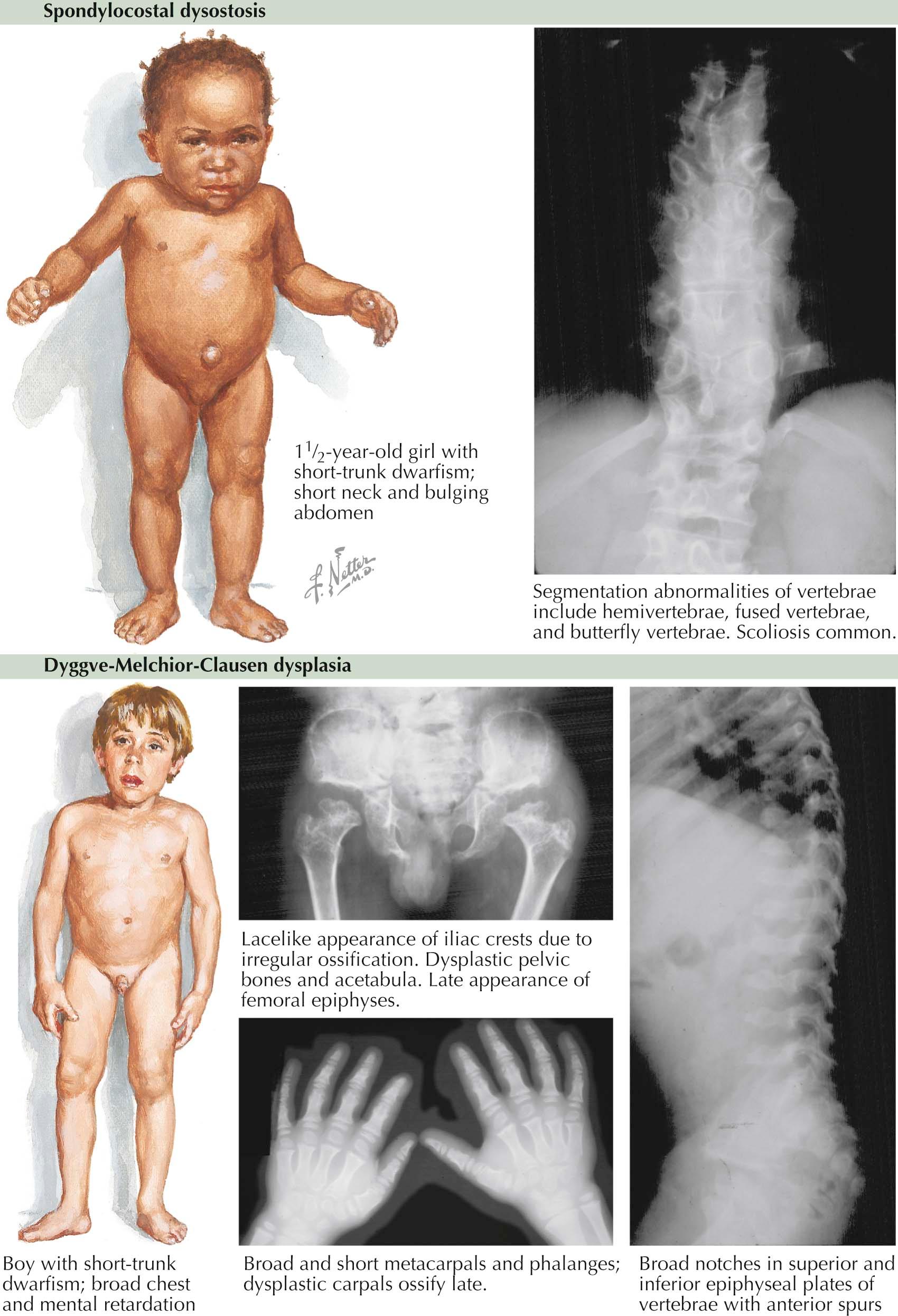
Syndromes that comprise vertebral and thoracic abnormalities have been called by many designations, and more data are needed for a complete understanding of this group of disorders. However, evidence suggests genetic heterogeneity in spondylocostal dysostosis with at least three phenotypes: (I) autosomal recessive with high mortality in the first 2 years; (II) autosomal recessive with good prognosis for survival; and (III) autosomal dominant with mild-to-moderate clinical manifestations.
Clinical Manifestations. Posterior shortening of the thorax and thoracolumbar lordosis are the major causes of short stature. The neck is short and often nearly immobile, and the head appears to rest on the shoulders. The limbs are long in relation to the trunk. The barrel chest bulges anteriorly, the lower anterior ribs may infringe on the iliac crests, and the abdomen protrudes. Recurrent respiratory infections are common and may be related to the chest deformity, pulmonary hypoplasia, or cor pulmonale. Laryngotracheomalacia is an uncommon feature.
Radiographic Findings. Severe vertebral abnormalities—hemivertebrae, fused (block) vertebrae, absent and butterfly vertebrae—characterize this disorder. The ribs are reduced in number, and the posterior costovertebral articulations may be bizarrely approximated, producing a fanlike radiation of ribs. The posterior shortening of the spine causes anterior flaring of the chest and deformity of the rib cage. No significant abnormalities are seen in the appendicular skeleton or skull.
Dyggve-Melchior-Clausen dysplasia is a rare and unusual disorder with an autosomal recessive inheritance.
Clinical Manifestations. Recognizable as early as 6 to 12 months of age, this disorder results in short-trunk dwarfism with a short neck, exaggerated lumbar lordosis, scoliosis, and prominent interphalangeal joints of the fingers with mild contractures and claw hand. Mental retardation and speech delay are common but not invariable. Adult height is about 52 inches.
Radiographic Findings. Radiographs reveal a generalized platyspondyly that usually persists into adulthood. In childhood, lateral views show anterior pointing of the vertebral bodies, with broad notches in the superior and inferior epiphyseal plates. The dens of the axis (odontoid process) may be hypoplastic. Irregular ossification of the iliac crests creates a characteristic lacelike appearance on radiographs. The ilia are short and broad.
In young children, the growth plates of the proximal femurs are horizontal, with prominent spurlike projections on the medial side of the femoral necks. Ossification of the femoral epiphyses is delayed, and the long bones are short with irregular epiphyseal and metaphyseal ossification.
Differential Diagnosis. Patients with this condition bear some resemblance to persons with Morquio syndrome (see Plate 4-18 ). However, there is no corneal clouding and the urine contains no keratan sulfate. In fact, studies of lysosomal enzymes and histologic examination refute the hypothesis that Dyggve-Melchior-Clausen dysplasia is due to an abnormality of mucopolysaccharide metabolism.
Become a Clinical Tree membership for Full access and enjoy Unlimited articles
If you are a member. Log in here